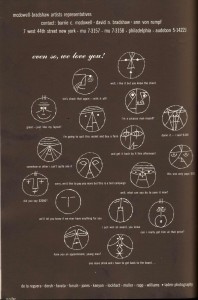In response to last month’s comics criticism roundtable, R. C. Harvey has a post up on the main site in which he lays out his philosophy of criticism.
But, seriously, a critic does what he does for what is a very shallow reason.
When I first set out to make a living in the world, I did it by teaching English in high school. Years later, one of my former students wrote and asked me why I chose teaching English as a profession. I thought about it and realized that I had no messianic purpose. I liked literature and I liked talking about it with others who liked literature and liked talking about it. I taught literature because that was a way of creating others who could talk about it in ways that were congenial with my own passion. It was a way of creating a conversation I enjoyed.
Harvey adds, “The other thing that criticism does, apart from gratifying the passions of the critic, is to enhance appreciation of the art being critiqued. In fact, I suggest that enhancing appreciation is the only legitimate function of criticism (beyond a critic’s self-indulgence).”
Logically enough, he then goes on to argue that the purpose of art, like that of criticism, is essentially to increase enjoyment.
The function of art, to pursue this topic into tedium, is to enhance enjoyment of life. A wise man once said, “The more things you like, the happier you’ll be.” Makes sense to me. Art—drawing, painting, music, and so forth—provide an assortment of things that one can choose from to like, thereby fostering one’s chances at being happy.
Harvey’s argument, then, as far as I understand it, is, first, that critics write for reasons which are shallow — because they happen to like things. Critics who claim to be writing for a higher (or lower?) purpose — such as, for example, to influence people, are fooling themselves. Or as Harvey puts it:
It would also be nice, and highly beneficial to mankind and civilization as a whole, if everyone would do exactly as I tell them—if cartoonists reformed and perfected their practices in accordance with my prescriptions, if other so-called critics started talking about comics as a visual art form as well as a narrative one, and if the Grumpy Old Pachyderm became the GOP of “Yes.” But—well, I, like most critics, may be self-absorbed, but I’m not delusional. Not yet.
The only legitimate purpose of criticism, then, according to Harvey, is to enhance appreciation of art. The purpose of art, in turn, is to make people happy. Thus, for comics critics, the goals are, (1) don’t delude yourself into thinking you have a deep and weighty purpose, and (2) make people happy.
_______________________
I’m going to take the second point first. Harvey presents this dictum (make people happy) as a common sense, non-weighty point (as he says, “Makes sense to me.”) I don’t think it’s either of those things, though. On the contrary, the rule-of-thumb that the goal of art and/or of life is to make people happy, and that making people happy can be tied to quantitative measures ( “The more things you like, the happier you’ll be.”) comes out of a very specific philosophical tradition: utilitarianism.
Utilitarianism is usually described as “the greatest good for the greatest number,” and while it may seem common-sensical, it’s implications lead to all sorts of crazy places. For example, if you take the logic of utilitarianism seriously, you could end up suggesting that starving parents eat their children. After all, the children would die anyway; if the parents eat them, the parents at least will live. It’s a common sense solution, right?
That scenario is, of course, a thumbnail paraphrase of Swift’s “A Modest Proposal.” Swift’s essay is art, in the sense that it is imaginative. It’s also criticism, or at least a critique. And what it’s critiquing is, in part, utilitarianism.
So…is Swift attempting to make us happy with his essay? Or is he attempting to make us — particularly if “us” means utilitarian thinkers of his time — unhappy? Does he want us to laugh at his cleverness, or does he want us to recoil in horror at the logic he puts forward, in the hopes that, by making us unhappy with the world, we may act to change it? No doubt there’s some of both in there — but surely it’s an oversimplification to say that Swift’s purpose, or his effect, is geared primarily, or solely towards making people happy.
And, in fact, art can have many goals other than happiness. Art can glorify god. It can be part of an effort to create community. It can criticize society in an attempt to change it. It can advance particular political interests. It can be intended as a moral lesson. It can try to sell us crap. And so forth.
Caro made some of these objections in comments, and Harvey responded
Art wouldn’t work to do all the things you say it does, Caro, if it didn’t also, and probably primarily, enhance our enjoyment of life. We expect it to do that, and in that expectation, we attend to art even when it is chiefly selling us something or promoting a political position.
The problem here is the problem with all monolithic definitions of complex phenomena — it’s reductive. A gospel song which explicitly tells you to turn away from enjoyment of life and embrace a glorious hereafter — is that meant to enhance our enjoyment of life? You could say “yes”, I suppose, and argue that the gospel singers are deluded about what they’re doing, or that believing in a hereafter actually enhances our enjoyment of life…but why go through all those tergiversations? Why, in short, does the “enjoyment” have to be the base, the real thing, while everything else is a secondary superstructure built on top of it? If someone says their art is intended to glorify god, or to pursue truth, or to change minds…why are those reasons less valid or legitimate or more self-indulgent? Why do they have to be transferred to a paradigm of “enjoyment” if they are to win Harvey’s imprimatur?
Or, to put it another way, whose enjoyment is enhanced, in short, by a definition of art which makes enjoyment the highest purpose? Is the enjoyment of devout Christians enhanced? The enjoyment of starving Irish peasants? Or is what’s at stake here the enjoyment of those of us who have come out modernity’s backside, for whom art is a commodity and commodity is a fetish?
“A wise man once said, “The more things you like, the happier you’ll be.” Who is this wise man? It’s not the Buddha, who would presumably argue that the fewer things you like the happier you’ll be. It’s not Moses, who told his people they’d be happier if they engaged in elaborate dietary rituals which certainly limited the number of things they could like. It’s not Kant, who believed true happiness was tied to not liking things. It’s not Marx, certainly…and not even, actually, Adam Smith, who believed fairly strongly that acquisition was not a simple game of numbers, but needed to be moderated by moral considerations. Indeed, it doesn’t, even on a commonsense level, seem to be the case that the more things you like the happier you are. Liking things can be fun, yes…but surely, liking and liking and liking in an acquisitive orgy of increase can, at times, get in the way of more important things. Like, for example, love.
I’m not saying here that Harvey is always wrong, or that it’s illegitimate to write criticism the goal of which is appreciation, or to create art the goal of which is happiness. My point is, rather, that these aren’t the only ways to approach art and criticism, and certainly not the only legitimate ways to do so. Aesthetics is about enjoyment in part, but it’s also about love, and faith, and even perhaps loathing and despair. To make it solely, or primarily, about enjoyment, I would argue, robs it of its enjoyment — turns it into a utilitarian and rather ugly machine.
So, again I ask, why does Harvey make this argument? Is he enhancing our enjoyment of life by presenting criticism as shallow and art as about happiness? Perhaps in part. But surely he also is doing exactly what he disavows; pushing an agenda, with at least some hope that it will affect or convince his readers. Humility can be a tyranny, too. “Shallowness” for Harvey is not just descriptive, but proscriptive —a stricture enforced by the waiting censure of “self-indulgence” and the accusation of “delusion.” It’s worth remembering, though, that another name for the self can be the soul, and that what one person sees as delusion, another may see as art.


